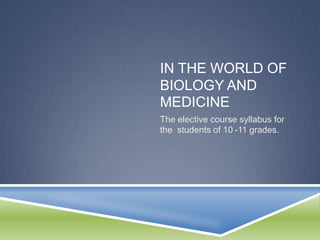
Syllabus
- 1. IN THE WORLD OF BIOLOGY AND MEDICINE The elective course syllabus for the students of 10 -11 grades.
- 2. DESCRIPTION The elective course is designed for the senior high school students, who learn English in the naturalistic field. The course was specifically developed to integrate the students’ knowledge and practice of English, Biology and Medicine. The syllabus is designed for Intermediate and Upper-Intermediate English learners.
- 3. AIM To provide students with a professionally-orientated English language training on the basis of the authentic popular-science texts, naturalistic video and audio materials.
- 4. OBJECTIVES To train students to take an active part in cross-cultural communication, using oral and written language skills. To form a perceived attitude towards choosing a job for life. To show the importance of using the English language in the framework of Biology and Medicine. To nurture students’ erudition and knowledge. To foster students’ naturalistic outlook and cognitive interests.
- 5. PLANNED OUTCOMES. PERSONAL. Students will form: A perceived attitude towards choosing a profession. Naturalistic outlook Cognitive interests
- 6. SUBJECTIVE. Students will learn: To recognize the lexical units, learned from the course, and use them in their speech following lexical rules. To use the active vocabulary in accordance with a communicative task. To participate in communication on the basis of profile-oriented topics. To express and defend their points of view on the highlighted course problematic questions. To do listening comprehension for general, detailed and requested information. To do reading on the topics, looking for general, detailed and requested information.
- 7. META-SUBJECTIVE. Students will master: Various skills of processing information from the texts, i.e. annotating, referencing, mind-mapping). An ability to communicate efficiently and effectively, while working in teams. Research and project skills.
- 8. THE STRUCTURE OF THE COURSE The course includes 41 hours* for 9 parts: 1. Introduction to the course – 1 hour. 2. Biology – 3 hours. 3. Aesthophysiology – 6 hours. 4. Medicine - 6 hours. 5. Microbiology – 6 hours. 6. Genetic Engineering – 5 hours. 7. Blood and its functions in a human body – 4 hours. 8. Biology and Medicine discoveries – 3 hours. 9. Final class – 3 hours. * Plus 2 hours for make-up classes.
- 9. TYPES OF STUDENTS’ INTERACTION Solo work Pair work Group work
- 10. CLASSROOM TECHNIQUES Brainstorming. Reading authentic scientific texts for general, detailed and requested information. Discussion of the texts. Debates on the problem. Collecting and reviewing information. Panel discussion. Watching scientific videos. Project making. Glossary making.
- 11. TYPES OF CONTROL Current: Final: Vocabulary dictation. Final test Definition test. The defense of the project. Reading test. Translation. Mind maps. Annotation. Summaries. Oral presentation. Mini – essay.
- 12. THANKS FOR YOUR ATTENTION